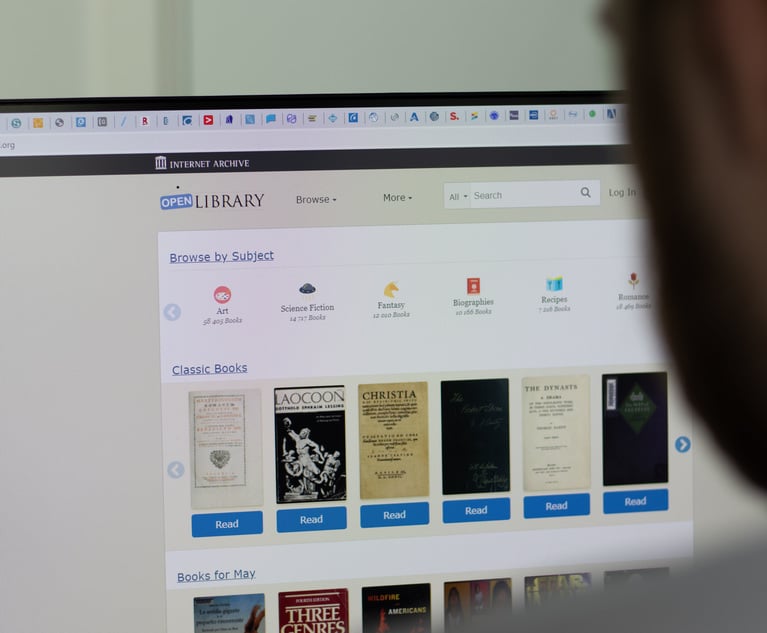Click Here to Waive a Jury Trial: 'Nicosia v. Amazon'
In his Intellectual Property column, Stephen M. Kramarsky, a member of Dewey Pegno & Kramarsky, discusses a recent Eastern District case that demonstrates the difficult questions raised by "clickwrap" and "browsewrap" agreements.
March 16, 2015 at 10:06 PM
14 minute read
By Stephen M. Kramarsky
Startup entrepreneurs love “disruption”—a buzzword that has come to mean sweeping out old models of delivery or consumption and replacing them with technological alternatives—but their lawyers often do not. The law can be slow to change, and its application to any new technology is never totally predictable. Just ask Aereo, the company that sought to disrupt television viewing with its miniature antenna technology until the U.S. Supreme Court shut it down last year. But even where the law itself may not “disrupt,” it does tend to adapt. Courts confronting novel issues of law often are inclined to look for analogies, molding older precedent to accommodate new situations.
This process has been particularly clear over the past several years, in the important area of contract formation. Every law student for well over a decade has read Judge Frank H. Easterbrook's seminal Seventh Circuit opinions Hill v. Gateway 20001 and ProCD v. Zeidenberg.2 These cases addressed issues of contract law that arose as consumers embraced new ways of buying and selling software and computers (and later a host of other goods) in the 1990s. They are often called the “shrinkwrap” cases because they tackle the issue of whether a consumer can be found to have agreed to contract terms after a purchase is made: The new terms are inside the “shrinkwrap” and the consumer accepts them by removing it and using the product. The shrinkwrap cases highlighted new ways of thinking about contractual relationships, emphasizing that they can be more fluid than courts had traditionally found. That flexibility has been crucial to the growth of online commerce and the rise of direct-to-consumer retail.
These cases are not taught because they are easy or because they represent the simple application of black-letter law. They are taught because they demonstrate how contract law can adapt to new commercial realities. And understanding this process is often helpful for lawyers who are faced with new issues and must advise their clients on likely outcomes, or argue for an application of existing law that would be beneficial to their clients' business model. On the Internet, for example, commercial transactions are fundamentally electronic: The vendor may provide only a service or may have no control over the physical packaging of any goods that are eventually supplied. Such a vendor has nothing to “shrinkwrap,” but still needs an efficient way to contract with its customers. As expected, the rise of these online service providers has created its own line of cases. They are the progeny of the shrinkwrap cases and address what are appropriately named “clickwrap” and “browsewrap” agreements. Although these agreements have been in use for decades, they continue to raise difficult issues in litigation, as demonstrated by a recent opinion issued by District Judge Sandra L. Townes of the Eastern District of New York.
Contracts on the Internet
There are two general types of agreements commonly entered into on the Internet: clickwrap and browsewrap agreements.3 In the typical “pure clickwrap” case, the user is confronted by the entire text of the agreement (typically called “terms of use,” an “end user license agreement,” or something similar) and cannot use the product or service until he or she affirmatively clicks on a button indicating acceptance of those terms.4 Anyone who has ever installed a piece of software knows that these agreements are rarely read; the vast majority of people hurriedly scroll through screen after screen of legal jargon before clicking “I Agree.” Nonetheless, these agreements are generally enforced in part because the user could (in theory) read through the agreement and, finding an unpalatable clause or two, click cancel to reject the product or service. Courts view the decision not to do so—or indeed the decision to ignore the text entirely—as tantamount to accepting the terms of the agreement.
This content has been archived. It is available through our partners, LexisNexis® and Bloomberg Law.
To view this content, please continue to their sites.
Not a Lexis Subscriber?
Subscribe Now
Not a Bloomberg Law Subscriber?
Subscribe Now
NOT FOR REPRINT
© 2024 ALM Global, LLC, All Rights Reserved. Request academic re-use from www.copyright.com. All other uses, submit a request to [email protected]. For more information visit Asset & Logo Licensing.
You Might Like
View All

Not All Secrets Are Trade Secrets: SDNY Examines the Limits of NDA Protection
13 minute read
'Rampant Piracy': US Record Labels File Copyright Suit Against French Distributor Believe
5 minute readTrending Stories
- 1Call for Nominations: Elite Trial Lawyers 2025
- 2Senate Judiciary Dems Release Report on Supreme Court Ethics
- 3Senate Confirms Last 2 of Biden's California Judicial Nominees
- 4Morrison & Foerster Doles Out Year-End and Special Bonuses, Raises Base Compensation for Associates
- 5Tom Girardi to Surrender to Federal Authorities on Jan. 7
Who Got The Work
Michael G. Bongiorno, Andrew Scott Dulberg and Elizabeth E. Driscoll from Wilmer Cutler Pickering Hale and Dorr have stepped in to represent Symbotic Inc., an A.I.-enabled technology platform that focuses on increasing supply chain efficiency, and other defendants in a pending shareholder derivative lawsuit. The case, filed Oct. 2 in Massachusetts District Court by the Brown Law Firm on behalf of Stephen Austen, accuses certain officers and directors of misleading investors in regard to Symbotic's potential for margin growth by failing to disclose that the company was not equipped to timely deploy its systems or manage expenses through project delays. The case, assigned to U.S. District Judge Nathaniel M. Gorton, is 1:24-cv-12522, Austen v. Cohen et al.
Who Got The Work
Edmund Polubinski and Marie Killmond of Davis Polk & Wardwell have entered appearances for data platform software development company MongoDB and other defendants in a pending shareholder derivative lawsuit. The action, filed Oct. 7 in New York Southern District Court by the Brown Law Firm, accuses the company's directors and/or officers of falsely expressing confidence in the company’s restructuring of its sales incentive plan and downplaying the severity of decreases in its upfront commitments. The case is 1:24-cv-07594, Roy v. Ittycheria et al.
Who Got The Work
Amy O. Bruchs and Kurt F. Ellison of Michael Best & Friedrich have entered appearances for Epic Systems Corp. in a pending employment discrimination lawsuit. The suit was filed Sept. 7 in Wisconsin Western District Court by Levine Eisberner LLC and Siri & Glimstad on behalf of a project manager who claims that he was wrongfully terminated after applying for a religious exemption to the defendant's COVID-19 vaccine mandate. The case, assigned to U.S. Magistrate Judge Anita Marie Boor, is 3:24-cv-00630, Secker, Nathan v. Epic Systems Corporation.
Who Got The Work
David X. Sullivan, Thomas J. Finn and Gregory A. Hall from McCarter & English have entered appearances for Sunrun Installation Services in a pending civil rights lawsuit. The complaint was filed Sept. 4 in Connecticut District Court by attorney Robert M. Berke on behalf of former employee George Edward Steins, who was arrested and charged with employing an unregistered home improvement salesperson. The complaint alleges that had Sunrun informed the Connecticut Department of Consumer Protection that the plaintiff's employment had ended in 2017 and that he no longer held Sunrun's home improvement contractor license, he would not have been hit with charges, which were dismissed in May 2024. The case, assigned to U.S. District Judge Jeffrey A. Meyer, is 3:24-cv-01423, Steins v. Sunrun, Inc. et al.
Who Got The Work
Greenberg Traurig shareholder Joshua L. Raskin has entered an appearance for boohoo.com UK Ltd. in a pending patent infringement lawsuit. The suit, filed Sept. 3 in Texas Eastern District Court by Rozier Hardt McDonough on behalf of Alto Dynamics, asserts five patents related to an online shopping platform. The case, assigned to U.S. District Judge Rodney Gilstrap, is 2:24-cv-00719, Alto Dynamics, LLC v. boohoo.com UK Limited.
Featured Firms
Law Offices of Gary Martin Hays & Associates, P.C.
(470) 294-1674
Law Offices of Mark E. Salomone
(857) 444-6468
Smith & Hassler
(713) 739-1250







